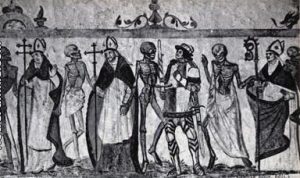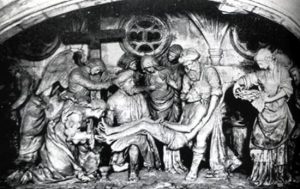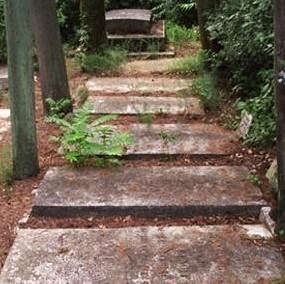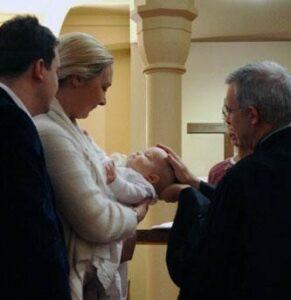The resurrection in the Bible
The idea of resurrection did not exist in old Israel.
Later on, once the Hebrews were exiled in Babylon, Persian influence led to the notion of resurrection. Among the majority of first century Jews it became their hope , but it was still a matter of debate.
In the New Testament, the resurrection of Christ is unique. Some texts in the Gospels talk of universal resurrection, while others of resurrection only for the righteous or those worthy of it. Paul the Apostle, in his epistles, emphasised the idea of resurrection. In first Corinthians (chapter 15) resurrection, understood as the deceased coming back in bodily form, was linked to the end of time. Thus in first Thessalonians (chapter 4) he comforted his bereaved brethren and wrote : “I would have that ye sorrow not, even as others which have no hope… the Lord himself shall descend from heaven… and those who have died in Christ shall rise first. Then we, and the living who remain, shall be caught up together with them,to meet the Lord in the clouds.”
The fear of Death and Judgement in the Middle-Ages
In the Middle-Ages the fear of death was linked to the impending Judgment day, when people’s true nature would be uncovered and punishment administered.
From the 15th century on, the “danse macabre” was frequently depicted in murals in churches, chapels, but mainly in galleries surrounding cemeteries. It featured death as a skeleton which led people of every age and social class in a frantic round. These paintings reflected the anxiety of people at that time. Indeed, Europe had endured famine, war and plague epidemics, particularly in the 14th century..
A number of scenes featuring Judgement day, presided over by Christ, were depicted on the typanums of Roman and Gothic churches. The Judgement determined your destiny after death :
- paradise for those worthy of being saved,
- hell for those who “deserved” damnation,
- purgatory for those who were not damned, but were not worthy of paradise, where they could purify themselves before going to paradise (doctrine of the Council of Lyon in 1274).
to redeem their faults and ensure their salvation, some undertook pilgrimage to faraway lands, especially to Jerusalem, Rome, or Saint James of Compostela, and were exposed to the risks of long and dangerous journeys.
To shorten one’s stay in purgatory, the Church sold masses and indulgences, the money from which was used to finance the building of the Basilica of Saint Peter in Rome. That was partly what triggered the Reformation.
The Reformation and its aftermath
To counteract the catholic doctrine of salvation through good deeds, the Reformation taught free salvation, given by God and not related at all to merit.
In claiming free salvation the reformers also rejected the idea of purgatory which is never mentioned in the Bible. They considered that life was intended solely to reveal the salvation that God awards us through Christ. So good deeds should be a result of our gratitude to God who saves us,, not based on the hope of divine reward.
Luther suggested an idea of the afterlife : either communion with God or separation from God following life on earth. Luther was noncommittal about immortality of the soul.
Conversely, Calvin considered the immortality of the soul to be a characteristic of man, which made him different from animals, and at the end of time God would give men’s bodies back to their souls.
Both reformers were conscious that the words they used to talk about the hereafter were conveying ideas but provided real information about eternal life. However, the speculations about what happens after death should not divert us from present tasks. The gospel was not given to satisfy our curiosity but to set us in the light shed by the promises it holds.
Nowadays most Lutheran and Reformed pastors claim God’s grace for everyone, while the declaration of faith of the Evangelical Alliance teaches resurrection of everyone for the Judgement or for life.
The Protestants and burial
In the 15th century Luther rejected extreme unction and the ceremony around death because Christ advocated only two sacraments, namely baptism and the Lord’s supper, and only for the living. The Reformation changed the attitude towards death : the dead being in God’s hand, the living cannot influence their fate, so there is no need to pray for them. Death and burial take place outside the Church. The pastor does not even have to attend the burial. Burial may be anywhere.
The Reformed Church were even more drastic their rejection of Catholic practices and went as far as to forbid eulogising the deceased. Calvin insisted on being buried somewhere secret. Calvin’s Discipline Ecclésiastique (Ecclesiastical Discipline) lays down that the pastor should not pray or preach during burials and that bells not be rung, in order to prevent any superstition. A prayer was allowed in the Temple only on the way back from the cemetery.
In the 17th century pastor Charles Drelincourt (1595-1669) even banned mourning which he considered too worldly.
With pressure from families, and to prevent conversions to Catholicism there were changes at the end of the 19th century. Since then pastors have presided over funeral services in Temples, and elsewhere, but such services are for the living and are meant to proclaim the Gospel, with the aim of. comforting the afflicted, enlightening the Church and evangelising those present. One does not pray for the deceased, however, the Lutheran liturgy for funerals gives the departed back to God, a kind of blessing for the deceased.
The ceremony called “Thanksgiving” is very often asked for, even by families who are not really practicing. There must be no eulogy for the departed, but members of the family or friends very often speak about the deceased during the ceremony ;
It generally, but not always, takes place with the deceased’s body present. In some places, e.g. the Languedoc or Cévennes ,the coffin is not allowed inside Reformed Temples. This is still the case in Nîmes but the church council may grant special dispensation. The pastor attends the interment in the cemetery, which may take place before the service in the Temple.
Today the church does not refuse assistance to those who ask for it in times of bereavement. Indeed, statistics for the Reformed Church show a significant proportion of services are for families of non-Protestants.
Burial grounds for the Protestants
In France, during the second half of the 16th century, Protestants could not be buried in “sacred” ground or even in neighbouring ground. The 1562 Edict of Amboise imposed burial at night, meaning at dawn or dusk. The 1598 Edict of Nantes officially granted them places to have their graveyards, where burials could take place by day. Three protestant cemeteries are currently in use in NÎmes.
But in 1685, a few months before the Revocation of the Edict of Nantes, an order issued by the Conseil d’Etat forbade the Reformed Church to have cemeteries in cities where worship was no longer conducted, and after the Revocation services were forbidden, along with burials of members of the “religion prétendue réformée “, who were supposed to have disappeared altogether. Burial grounds in Nîmes were taken over by the Catholics in 1688. After the Revocation, the “Church of the Desert” looked for burial sites to avoid corpses being thrown out on the streets. The Protestants had to bury their dead secretly. City dwellers did it in the cellars of their houses or their in gardens, whereas country dwellers devoted a field to burials, which accounts for the number of private cemeteries in the Cévennes, Languedoc and Poitou regions, still in use nowadays.
In 1736 a judicial procedure allowed burial of the Reformed. It was a lay procedure in which the priest, who held the register of deaths, played no role : the King knew who had died in his kingdom and the details of the burial. In 1776, for public health reasons, the King’s letters patent obliged the movement of cemeteries to outside cities. The 1787 Edict of Tolerance allowed the Protestants to bury their dead in cemeteries again. The city halls were compelled to supply burial ground to non-catholic subjects, and thus protestant cemeteries could be re-established.
Today Protestants are buried in municipal cemeteries and also in some Protestant cemeteries, as well as in family tombs on private estates. Cremation is increasingly common among Protestants as well as among the general population.








